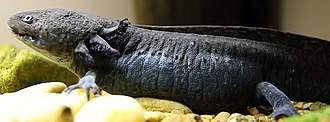Mexican axolotl (pronounced ACK-suh-LAH-tuhl) salamanders are amphibians that spend their whole lives underwater. They exist in the wild in only one place—the lake complex of Xochimilco (pronounced SO-chee-MILL-koh), a network of artificial channels, small lakes, and temporary wetlands that help supply water to nearby Mexico City’s 18 million residents.
A sexually mature adult axolotl, at age 18–27 months, ranges in length from 15 to 45 cm (6 to 18 in), although a size close to 23 cm (9 in) is most common and greater than 30 cm (12 in) is rare. Axolotls possess features typical of salamander larvae, including external gills and a caudal fin extending from behind the head to the vent.[11][12] External gills are usually lost when salamander species mature into adulthood, although the axolotl maintains this feature.[13] This is due to their neoteny evolution, where axolotls are much more aquatic than other salamander species.
Their heads are wide, and their eyes are lidless. Their limbs are underdeveloped and possess long, thin digits. Males are identified by their swollen cloacae lined with papillae, while females are noticeable for their wider bodies full of eggs. Three pairs of external gill stalks (rami) originate behind their heads and are used to move oxygenated water. The external gill rami are lined with filaments (fimbriae) to increase surface area for gas exchange.[13] Four-gill slits lined with gill rakers are hidden underneath the external gills, which prevent food from entering and allow particles to filter through.
The axolotl is native only to the freshwater of Lake Xochimilco and Lake Chalco in the Valley of Mexico. Lake Chalco no longer exists, having been drained as a flood control measure, and Lake Xochimilco remains a remnant of its former self, existing mainly as canals. The water temperature in Xochimilco rarely rises above 20 °C (68 °F), although it may fall to 6–7 °C (43–45 °F) in the winter, and perhaps lower.[18]
Surveys in 1998, 2003, and 2008 found 6,000, 1,000, and 100 axolotls per square kilometer in its Lake Xochimilco habitat, respectively.[19] A four-month-long search in 2013, however, turned up no surviving individuals in the wild. Just a month later, two wild ones were spotted in a network of canals leading from Xochimilco.
The wild population has been put under heavy pressure by the growth of Mexico City. The axolotl is currently on the International Union for Conservation of Nature's annual Red List of threatened species. Non-native fish, such as African tilapia and Asian carp, have also recently been introduced to the waters. These new fish have been eating the axolotls' young, as well as their primary source of food.
The feature of the axolotl that attracts most attention is its healing ability: the axolotl does not heal by scarring and is capable of the regeneration of entire lost appendages in a period of months, and, in certain cases, more vital structures, such as tail, limb, central nervous system, and tissues of the eye and heart.[26] They can even restore less vital parts of their brains. They can also readily accept transplants from other individuals, including eyes and parts of the brain—restoring these alien organs to full functionality. In some cases, axolotls have been known to repair a damaged limb, as well as regenerating an additional one, ending up with an extra appendage that makes them attractive to pet owners as a novelty. In metamorphosed individuals, however, the ability to regenerate is greatly diminished. The axolotl is therefore used as a model for the development of limbs in vertebrates.[27] There are three basic requirements for regeneration of the limb: the wound epithelium, nerve signaling, and the presence of cells from the different limb axes.[28] A wound epidermis is quickly formed by the cells to cover up the site of the wound. In the following days, the cells of the wound epidermis divide and grow quickly forming a blastema, which means the wound is ready to heal and undergo patterning to form the new limb.
It is believed that during limb generation, axolotls have a different system to regulate their internal macrophage level and suppress inflammation, as scarring prevents proper healing and regeneration.[29] However, this belief has been questioned by other studies.[30] Axolotl’s regenerative properties leave the species as the perfect model to study the process of stem cells and its own neoteny feature. Current research can record specific examples of these regenerative properties through tracking cell fates and behaviors, lineage tracing skin triploid cell grafts, pigmentation imaging, electroporation, tissue clearing and lineage tracing from dye labeling. The newer technologies of germline modification and transgenesis are better suited for live imaging the regenerative processes that occur for axolotls.
The 32 billion base pair long sequence of the axolotl's genome was published in 2018 and was the largest animal genome completed at the time. It revealed species-specific genetic pathways that may be responsible for limb regeneration.[32] Although the axolotl genome is about 10 times as large as the human genome, it encodes a similar number of proteins, namely 23,251[32] (the human genome encodes about 20,000 proteins). The size difference is mostly explained by a large fraction of repetitive sequences, but such repeated elements also contribute to increased median intron sizes (22,759 bp) which are 13, 16 and 25 times that observed in human (1,750 bp), mouse (1,469 bp) and Tibetan frog (906 bp), respectively.
